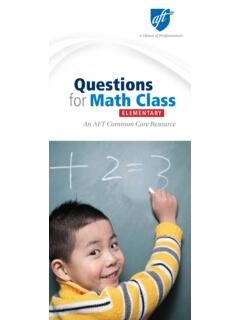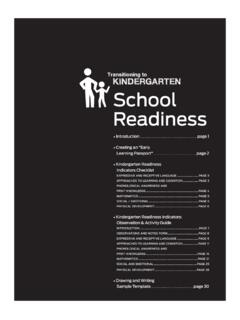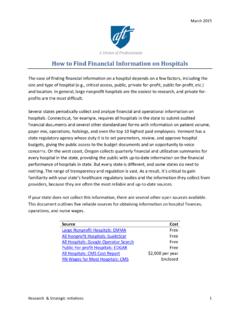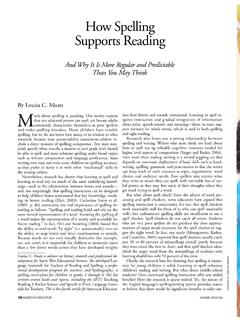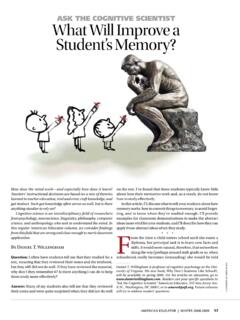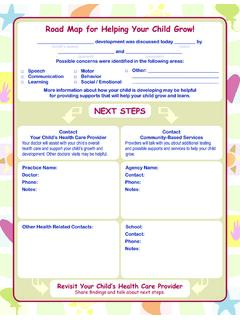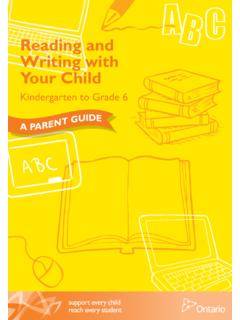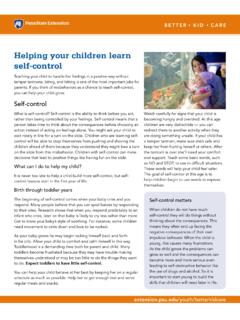Transcription of Helping Your Child Become a Reader - AFT
1 Helping your Child Become a Department of Education Margaret Spellings, Secretary OctOber 2008 This booklet is in the public domain. Authorization to reproduce it in whole or in part for educational purposes is granted. While permission to reprint this publication is not necessary, the citation should Department of education Office of communications and Outreach Helping your Child Become a Reader 2005 Washington, American Federation of Teachersrandi Weingarten, presidentAntonia cortese, secretary-treasurerLorretta Johnson, executive vice presidenteducational Issues DepartmentJohn Mitchell, DirectorThe AFt represents more than million pre-K through 12th-grade teachers; paraprofessionals and other school-related personnel; higher education faculty and professional staff; federal, state and local government employees; nurses and healthcare workers; and early childhood educators people who know how important it is for educators and parents to work together to support children s their work with parents, school staff regularly hear about the need for good materials that families can use to help their children learn outside the booklet is filled with interesting and fun activities parents can use at home to promote their children s interest and skill in reading.
2 As part of it s efforts to build family support for learning, the AFt is making this booklet available to it s members for distribution to parents at events such as open houses, back-to-school nights, home visits, PtA meetings and parent s books and magazines are mentioned in this booklet as examples and are only a few of many appropriate children s books and periodicals. Other materials mentioned are provided as resources and examples for the Reader s convenience. Listing of materials and resources in this book should not be construed or interpreted as an endorsement by the Department of any private organization or business listed herein. Helping your Child Become a Reader FIrSt PUbLISHeD In SePteMber 2000. revISeD 2002 AnD bY WHItneY SHerMAnHelping your Child Become a ReaderWith activities for children from infancy through age 6originally Produced By the u. s. dePartment of educationadditional information Provided By the american federation of teachersii | Helping your Child Become a readeryears of research show clearly that children are more likely to succeed in learning when their families actively support them.
3 When you and other family members read with your children, help them with homework, talk with their teach-ers and participate in school or other learning activities, you give your children a tremendous than Helping your children to grow up healthy and happy, the most important thing that you can do for them is to help them develop their reading skills. It is no exaggera-tion to say that how well children learn to read affects directly not only how successful they are in school but also how well they do through-out their lives. When children learn to read, they have the key that opens the door to all the knowledge of the world. The foundation for learning to read is in place long before children enter school and begin formal reading instruction. You and your family help to create this foundation by talking, listen-ing and reading to your children every day and by showing them that you value, use and enjoy reading in your lives. This booklet includes activities for families with children from infancy through age 6.
4 Most of the activities make learning experiences out of the everyday routines in which you and your children participate. Most use materials that are found in your home or that can be had free of charge from your local library. The activities are designed to be fun for both you and your children as you help them to gain the skills they need to Become readers. enjoy them! foreword Helping your Child Become a Reader | iii Introduction | ivBecoming a Reader | 1 Talking and Listening | 1 Reading Together | 2 Learning about Print and Books | 3 Early Efforts To Write | 4 Reading in Another Language | 4 Activities | 6 Baby Talk | 6 Books and Babies | 7 Chatting with Children | 7 As Simple as ABC | 8 What Happens Next? | 8 A Home for My Books | 9 A Picture s Worth a Thousand Words | 9 Rhyme with Me: It s Fun, You ll See! | 10 Match My Sounds | 12 Take a Bow! | 12 Family Stories | 13 Write On! | 13 Other Ways to Help | 15 Visiting the Library | 15 Learning with Computers | 16 Taking Charge of TV | 16 If You Think There s a Problem | 19A Reading Checklist | 21 Typical Language Accomplishments | 22 Resources for Families and Caregivers | 24 Resources for Children | 28 Bibliography | 33 Simple Strategies for Creating Strong Readers | 34contentsiv | Helping your Child Become a reader_____* Please note: In this booklet, we refer to a Child as him in some places and her in others.
5 We do this to make the booklet easier to read. Please understand, however, that every point that we make is the same for girls and could say that your baby starts on the road to becoming a Reader on the day she* is born and first hears the sounds of your voice. every time you speak to her, sing to her and respond to the sounds that she makes, you strengthen your Child s understanding of language. With you to guide her, she is well on her way to becoming a understand the connection between a Child s early experiences with spoken language and learning to read, you might think of language as a four-legged stool. The four legs are talking, listening, reading and writing. All four legs are important; each leg helps to support and bal-ance the booklet gives you information about how you can use your language skills to build your Child s skills. It offers suggestions about how you can: talk with and listen to your Child . read together with her. Help your Child learn about books and print.
6 Encourage your Child s early writing efforts. Help your Child learn to read if her first lan-guage is not english. Prepare your Child for success in school. The major portion of the booklet contains activities that you can use with your Child to strengthen her language skills and encourage her love of reading. However, these activities are only a starting point. We hope that you and your Child will enjoy them enough to create and try many more on your own. As a parent, you are your Child s first and most important teacher. You don t need to be the best Reader to help your time and interest and the pleasure that you share with your Child as part of read-ing together are what counts. If you would like more information about Helping your Child with reading, this booklet also provides lists of books and Web sites and the names of groups that you can contact. We all know that older children can do things that younger ones can t. This is true for reading, too.
7 To help show when children can take cer-tain learning steps, this booklet ties the discus-sion and activities to four age groups: baby: birth to 1 year toddler: 1 to 3 years Preschooler: ages 3 and 4 Kindergartner/early first-grader: ages 5 and 6 Keep in mind, however, that children don t all learn at the same pace. And even though introduction Helping your Child Become a Reader | v they learn new things, they may have old favorites books and activities from earlier years that they still enjoy. You are the best person to decide which activities will work best for your Become readers step by step. by age 7, most children are reading. Some take lon-ger than others and some need extra help. When children receive the right kind of help in their early years, reading difficulties that can arise later in their lives can be prevented. This booklet offers steps that you can take to start your Child on the way to becoming a successful Reader . It is an adventure that you will not want to miss and the benefits for your Child will last a lifetime.
8 When children receive the right kind of help in their early years, reading difficulties that can arise later in their lives can be prevented. Helping your Child Become a Reader | 1 every step a Child takes toward learn-ing to read leads to another. bit by bit, the Child builds the knowledge that is necessary for being a Reader . Over their first 6 years, most children: talk and listen. Listen to stories read aloud. Pretend to read. Learn how to handle books. Learn about print and how it works. Identify letters by name and shape. Identify separate sounds in spoken language. Write with scribbles and drawing. connect letters with the sounds they make. connect what they already know to what they hear read. Predict what comes next in stories and poems. connect combinations of letters with sounds. recognize simple words in print. Sum up what a story is about. Write individual letters of the alphabet. Write words.
9 Write simple sentences. read simple books. Write to communicate. children can take more than one of these steps at the same time. This list of steps, though, gives you a general idea of how your Child will progress toward reading. (For more details, see typical Language Accomplishments. ) Talking and ListeningScientists who study the brain have found out a great deal about how we learn. They have discovered that babies learn much more from the sights and sounds around them than we thought previously. You can help your baby by taking advantage of her hunger to the very beginning, babies try to imitate the sounds that they hear us make. They read the looks on our faces and our movements. That s why it is so important to talk, sing, smile and gesture to your Child . Hearing you talk is your baby s very first step toward becoming a Reader , because it helps her to love language and to learn words. (See baby talk. )As your Child grows older, continue talking with her.
10 Ask her about the things she does. Ask her about the events and people in the stories you read together. Let her know you are listening carefully to what she says. by engaging her in talking and listening, you are also encouraging your Child to think as she speaks. In addition, you are showing that you respect her knowledge and her ability to keep learning. (See chatting with children. )Becoming a Reader Hearing you talk is your baby s very first step toward becoming a | Helping your Child Become a readerReading TogetherImagine sitting your baby in your lap and reading a book to him for the first time. How different from just talking! now you re showing him pictures. You point to them. In a lively way, you explain what the pictures are. You ve just helped you Child take the next step beyond talk-ing. You ve shown him that words and pictures connect. And you ve started him on his way to understanding and enjoying books. While your Child is still a baby, reading aloud to him should Become part of your daily routine.

